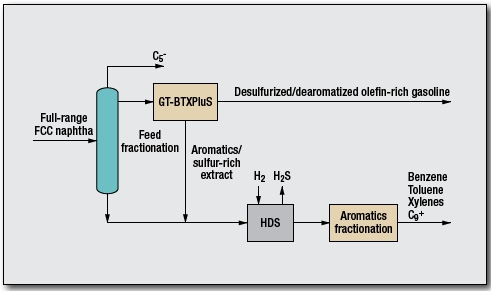GT-BTX PluS is a variation of GT-BTX that uses extractive distillation technology for simultaneous recovery of benzene, toluene and xylene (BTX) and thiophenic sulfur species from refinery or petrochemical aromatic containing streams. The technology helps produce low-sulfur gasoline meeting the 10 ppm limit of sulfur without changes in octane value.

The optimum feed is the mid-fraction of FCC gasoline from 70°C–150°C. This material is fed to the GT-BTX PluS unit, which extracts the sulfur and aromatics from the hydrocarbon stream. The sulfur-plus aromatic components are processed in a conventional hydrotreater to convert the sulfur into hydrogen sulfide (H2S). Because the portion of gasoline being hydrotreated is reduced in volume and free of olefins, hydrogen consumption and operating costs are greatly reduced.
The stream from the feed fractionation unit is fed to the extractive distillation column (EDC). In a vapor-liquid operation, the solvent extracts the sulfur compounds into the bottoms of the column along with the aromatic components, while rejecting the olefins and non-aromatics into the overhead as raffinate. Nearly all of the non-aromatics, including olefins, are effectively separated into the raffinate stream. The raffinate stream can be optionally caustic washed before routing to the gasoline pool or to other units such as aromatization, olefins to diesel, or olefin alkylation to fully utilize this olefin-rich stream.
Rich solvent, containing aromatics and sulfur compounds, is routed to the solvent recovery column (SRC) where the hydrocarbons and sulfur species are separated, and lean solvent is recovered in column bottoms. The SRC overhead is hydrotreated by conventional means and either used as desulfurized gasoline or directed to an aromatics plant. Lean solvent from the SRC bottoms is recycled back to the EDC.
Process advantages:
• Eliminates FCC gasoline sulfur species to meet a pool gasoline target of 10 ppm sulfur.
• Rejects olefins from being hydrotreated in the hydrodesulfurization (HDS) unit to prevent loss of octane rating and to reduce hydrogen consumption.
• Fewer components (only the heavy-most fraction and the aromatic concentrate from the ED unit) sent to hydrodesulfurization,
resulting in a smaller HDS unit and less yield loss.
• Purified benzene and other aromatics can be produced from the aromatic-rich extract stream after hydrotreating.
• Olefin-rich raffinate stream can be directed to other process units for product upgrade.
Licensor: GTC Technology